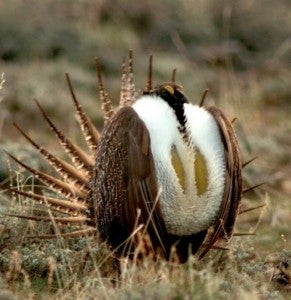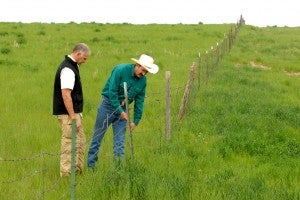No time to wait: sage grouse delay gives urgency to conservation

You may have seen a strange looking bird causing quite a stir in the news recently. That’s because there’s a lot at stake with the greater sage-grouse, especially now that a rider in the federal spending bill prevents the U.S. Fish and Wildlife Service from listing the species under the Endangered Species Act in 2015 (a decision was originally expected in September). But this delay isn’t stopping ranchers, conservationists and other key stakeholder from moving full speed ahead to find a solution.
You might not get this sense from the political dialog and the media, but out on the ground, there is a real spirit of cooperation when it comes to the greater sage-grouse. That’s because everyone realizes that – rider or no rider, listing or no listing – this bird needs help.
Greater sage-grouse once numbered in the millions, but in the past 30 years its population has shrunk 30 percent to no more than 500,000 birds, and it could be less than half that. We don’t have another year to sit back and watch populations decline further. Doing nothing will only increase the need for federal action in the future.
The best thing we can do is to use this time to build a conservation program that works – fast.
That’s exactly what state agencies, landowners, energy companies and conservation groups are trying to do through habitat exchanges, which will enable landowners such as ranchers and farmers to get paid for growing sage-grouse habitat.
“We are more determined than ever to work with the states, ranchers, energy developers and other stakeholders who are putting effective conservation measures in place with the shared goal of reaching a ‘not warranted’ determination.” — Interior Secretary Sally Jewell
Habitat exchanges are unique in that they’ve been designed to work whether or not a species is actually listed – providing incentives to get good conservation on the ground before any last minute Hail Mary federal protections are needed.
“Research has shown that society can better avoid significant costs with upfront actions, rather than reactive regulations,” said Terry Fankhauser, executive vice president of the Colorado Cattlemen’s Association. “Everyone sees the opportunity; they realize that species like the greater sage-grouse can thrive as a managed component of a successful beef cattle ranch.”

What landowners can do now
There is a number of voluntary conservation activities that landowners can choose from to participate in an exchange, all of which are conducive to agricultural practices like cattle ranching. These activities include:
- Controlling the expansion of pinyon-juniper trees into sagebrush habitats;
- Permanently protecting the best sagebrush habitats from development;
- Restoring sagebrush on degraded lands;
- Managing livestock grazing to improve habitat;
- Controlling the expansion of invasive plants that degrade habitat.
The sooner landowners can engage in activities like this, the sooner we will see sage-grouse populations grow and the better prepared we will be when the Fish and Wildlife Service makes a final determination.
We should all want to see populations grow so that a listing is not necessary. But crossing our fingers and hoping for the best is not a winning strategy. We must nurture the productive partnerships that have already been developed in sage-grouse country to promote solutions like habitat exchanges that benefit everyone: the oilman, the cattle rancher and the sage-grouse.












